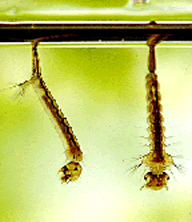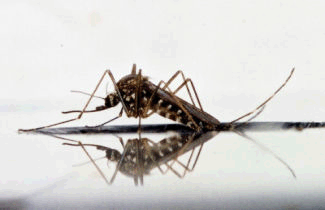 What is West Nile Virus?
What is West Nile Virus?
A few different species of mosquitos can spread West Nile Virus to people but only if they have fed on the blood of infected birds. It first appeared in North America in 1999. In Canada, the virus first appeared in Quebec, Ontario, Manitoba, Saskatchewan and Alberta. While West Nile Virus has shown up in British Columbia and Washington, the Province of B.C. says there is little risk in Victoria. It has discontinued its preparedness program in the region.
Where it occurs, the risk of contracting West Nile Virus is highest during the mosquito season (mid-April through September). The risk of getting infected is very low.
- Most who contract West Nile Virus show no symptoms at all.
- 20% will develop flu-like symptoms.
- In very rare cases (1%), the virus can cause severe illness.
The best way to protect yourself and your family is to avoid mosquito bites if you live where West Nile has shown up.
- Our Response
- How to protect yourself
- Reduce mosquitos around your home
- If you have a pond
- Pesticide options
- What is Bti
Our Response
We base our West Nile Virus Response Plan on several years of inventory and monitoring. If the Provincial government tells us to take action, we’re ready.
In an outbreak, our main response will be to manage catch basins. Under some conditions, catch basins can become mosquito breeding habitat. Catch basins are next to the curb or edge of roads. They collect rain water, allow sediments to settle out and direct the rain water to the nearest body of water.
With no West Nile Virus, we don’t actively control mosquito populations. We do keep a list of problem areas to address if an outbreak happens. There are many factors that can cause mosquito populations to fluctuate. We will investigate mosquito breeding grounds to see if there is a drainage problem that we can address without harming the environment. We continue to improve habitat for mosquito and larvae predators in natural areas.
To report dead birds
As part of the monitoring process, please contact the BC Centre for Disease Control.
How to protect yourself
It’s most effective to keep mosquitos from biting you.
- Avoid the outdoors at dawn and dusk when they are most active.
- Wear clothes thatcover your arms and legs.
- Wear a hat.
- Wear light coloured clothes. Mosquitos are attracted to dark clothing.
- Ensure door and window screens actually keep mosquitos outdoors.
- Use insect repellent when outside.
Reduce mosquito breeding areas around your home
Many mosquitos come from small sources of standing water around the home. Some breed in the upper intertidal areas along our coast.
Mosquitos need standing water to lay their eggs in. Even a small amount of standing water can provide breeding areas. In ideal conditions, some mosquitos can develop into adults in less than a week.
It’s easy to spot larvae. Look for small aquatic insects (wrigglers) that suspend themselves at the surface of water and wiggle below if you disturb them.
- Empty standing water from things like pool covers, saucers under gardening pots, buckets, recycling bins and garbage cans.
- Clear your property of unused items like old tires that could collect water.
- Change water twice a week in things like bird baths, pet bowls, wading pools and livestock watering tanks.
- Use screens to cover rain barrels.
- Regularly clean eave troughs to avoid standing water.
- Do not overwater lawns or wash cars in your driveway. The water goes into the catch basins on your street, providing breeding habitat.
What do I do if I have a pond?
A healthy wetland with native aquatic plants and insects will produce very few mosquitos. Don’t do anything that may upset the balance.
Problem mosquitos can come from many sources. Be sure to check your entire property for mosquito breeding areas in standing water first (see tips above). Then check your ponds for the tell-tale larvae. If you have a small pond, or a pond with an unbalanced ecosystem, you have a few options.
- Encourage your ponds to reach a natural state of balance by planting native plants.
- Manually remove mosquito larvae with a small gauge aquarium net. Scoop the wriggling insects at the water’s surface.
- Temporarily drain the water source. Remember that mosquitos will very quickly re-colonize an area.
- Install an aerator or pump that will keep the surface water moving. This makes the pond unsuitable for mosquito egg-laying and unwelcoming to the larvae.
- Attract mosquito predators like bats, swallows or dragonflies to your yard.
If your wetland is natural, or is connected to a natural waterway like a creek or lake, it is illegal to put fish in it. Be sure to contact the proper authorities for advice before introducing fish.
Can I use pesticides?
For the health of the environment and your family, we don’t recommend pesticides. Using a pesticide of any type in a pond or wetland disrupts the normal balance of predators and prey.
Issues
- Pesticides affect non-target organisms.
- They can also create new, and sometimes even better breeding habitat.
- Mosquitos can develop a resistance to the pesticides.
Biological Larvicide
If you find water with mosquito larvae on your property and you have tried all the tips above, you do have a pesticide option. Mosquito pesticide targets the immature life-stages, which are confined to water. You can get biological larvicides from your local home-and-garden centre. These contain naturally occurring bacteria called Bacillus thuringiensis israelensis (Bti). It targets all species of aquatic flies. 10% of all flies live in water as larvae. Many of them are food for other animals like dragonflies, birds, amphibians, fish and bats. Some of these flies even hunt mosquitos.
Note: commercial pesticides can only be applied by certified pesticide applicators.
What is Bti?
- Bacillus thuringiensis israelensis (Bti)
- Naturally occurring soil bacterium
- Used as a biological pest control agent in standing water where mosquitos breed
What it does
Bti produces a protein crystal that, once ingested by the feeding larvae, kills all flies by damaging their digestive system. They can’t feed and die within days.
Bti has been used since 1982. Health Canada has determined that it only affects aquatic flies and it poses little threat to human health. The weight of scientific evidence indicates that Bti is non-infectious and non-toxic to humans and other mammals. It poses little risk at dosage levels permitted in insect control programs.
Issues of Bti
- Mosquitos can develop resistance to it over time.
- When put in a healthy wetland ecosystem, it can do the opposite of what you want. It can create a predator-free environment that new mosquitoes can colonize and thrive in.


